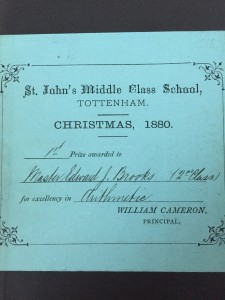http://www.booktraces.org/submission-successful/
While searching in the stacks, I came across a small, dark green, hard-backed book with gold leafing on the pages and the front and back covers. It was titled “William Cullen Bryant; A Biographical Sketch, With Selections From His Poems and Other Writings.” The first thing i noticed was this inside cover because of the blue sticker attached to it. The sticker includes a decorative font and appears to be a gift tag for a christmas gift from the principal, to a student (Master Edward J. Brooks) at St. John’s Middle Class School in Tottenham, for “Excellence In Arithmetic.” This book was the first prize award. What really struck me was the fact that this was made out is 1880! The calligraphy it is written in is amazing and beautiful. The book itself was published in Gaslow in March of 1880, and given as a gift in December 1880. The author is A.J. Symington. Aside from the prize tag, there is no personal writing or other marginalia in the book. The book is falling apart and the pages are brown and pulpy. It is so amazing and interesting that we can see time paralleled, and personal relations through history. I looked up Tottenham: an area in the London Borough of Haringey, in north London, England, about 8 miles northeast of Charing Cross. How did this book, belonging to a man named Edward Brooks in England end up in the New School Library which would later become SUNY New Paltz’s Library system? It’s amazing trying to think of the many ways this could have happened, but also how fortunate for us here at this school to have such a worldly, historic collection amongst us for use. I was so amazed that i was able to check out some of these beautiful old books that are pretty much historical documents themselves.

